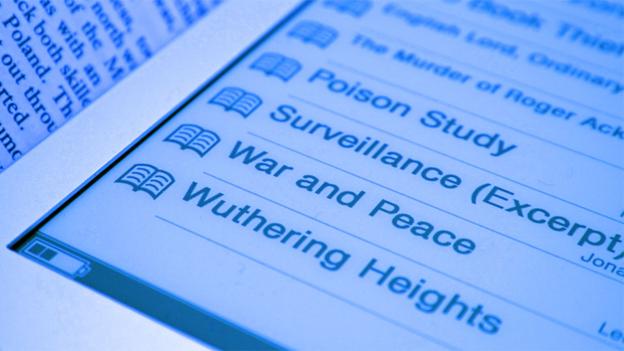L' UNICA VERSIONE ORIGINALE DEL LIBRO E' IN MIO POSESSO IN ITALIA..
FINISCO FACENDOVI PRESENTE CHE A SCOPO DELLA MIA TUTELA LEGALE DELLA PROPIETA INTELLETUALE LA PROVA FISICA E' DETERMINATE.
-ARTICOLO SU BBC:
Life:Connected | 20 August 2012
A new chapter for ebooks
Tom Chatfield
Technology,E-book,Gadget

Sony e-book reader
Ebooks still lack many of the characteristics that make their physical
counterparts so popular, but that could soon change, says Tom Chatfield.
“It’s the texture of the page, for me.”
“It’s that reassuring weight they’ll never replace”.
In the ongoing debates about the rise of the ebook, you generally don’t have to wait long until someone invokes the physical attributes of mouldering bookshelves as the missing ingredient from electronic texts.
Yet you don’t have to make a fetish of physicality to notice that there are several ways in which the business of owning and reading an electronic book remains inferior to doing the same with a paper copy. And, ironically enough, the most significant of these involves something at which digital media allegedly excel: sharing.
When I lend a friend one of the physical books off my shelves, I’m not just giving them access to a virgin chunk of text, as I would be if I sent them a copy of an electronic file. I’m passing on a physical object that – in my case at least – is likely to come equipped with annotations, underlinings, tea stains, and a well-thumbed sense of what caught my attention. In some cases, it will also boast several previous owners’ worth of these. And when I get it back, a little more history will come back too.
At the moment, while the internet boasts near-endless opportunities on blogs, message boards and social networks for discussing and discovering books of all kinds, there’s almost no integration between these communities and books themselves; a circumstance whose difficulties are compounded by the prevalence of so-called DRM, or Digital Rights Management, among most mainstream publishers.
To get a quick and dirty sense of Digital Rights Management, consider the difference between owning a book, and merely owning the right to read a book under certain circumstances – say on a limited number of devices or for a limited period of time. The first is what traditional print publishing offers. The second is the DRM model – one intended to protect publishers and authors against piracy. Except, as has been found time and time again, these digital locks also prevent readers from doing what they want with the books they have bought. Not to mention giving them a convenient excuse to seek out DRM-free pirated copies of books that were supposed to have been prevented by DRM in the first place.
From music to film, other industries have already passed through their own versions of the DRM dilemma when it comes to digital media – and debate and divisions continue to range, with music on iTunes DRM-free since 2009, but much online video and most video games still locked into specific rights systems.
‘Unread and unreadable’
Books are playing a rapid game of digital catch-up here – and, given the proclivities of many of DRM’s most vocal opponents, it’s perhaps no surprise that this month it was the world’s biggest science fiction publisher, Tor Books, that became the first imprint among publishing’s “big six” players to start offering all of its digital books without any rights restrictions.
It marks, as Tor author and digital campaigner Cory Doctorow put it,
“a seismic event in the history of the publishing industry”. To me,
though, what it also suggests is the tantalizing possibility of helping
digital reading preserve all the advantages of its weightless,
infinitely capacious medium while regaining some of the rich
possibilities of physical books – and specifically those communities of
lending, discussion, sharing and recommendation that are the traditional
lifeblood of reading.
DRM is far from the only issue here. But the potential opening up of ebook formats by mainstream publishers brings with it the possibility of a new opening up of the apparatus surrounding reading as a digital experience. From universally shared annotations and highlights to the passing on of personal reading histories and personalised editions, the opportunities for integrating everyday digital reading with genuinely open communal tools are legion. Perhaps above all, though, what such openness most tantalisingly promises is a shift in emphasis within digital books away from a handful of digital “ecosystems” and back towards readers, writers and publishers. If this sounds slightly utopian, well, that’s because it is. It shouldn’t stretch credibility too far, though, to note that belief in the very notion of “books” enduring as a 21st Century form requires more than gathering together a certain number of words. If they are to maintain vigour and impact within the brutally Darwinian internet world, both textual aspirations of permanence and a corresponding density of cultural engagement are urgently required: the mutually invigorating embrace, in other words, of authors and audiences. One of the adages of digital media has long been that relationships matter more than mere purchases: between creators and consumers, but also within those communities of consumers who have an increasingly vocal impact on the creative process. In this context, it’s always been one of the stranger current features of eBooks that digital and print formats are locked in such mortal combat, given not only that the same people buy both, but that the bulk of this buying is done by self-proclaimed book lovers who would relish the opportunity to connect texts’ physical and virtual incarnations. Whether it’s discounted physical copies for owners of digital books, digital editions bundled with physical purchases, or some other arrangement, pitting old against new is a poor reflection of what readers and writers alike actually want. As the author Charlie Stross argued earlier this year, the most dismal fate any ebook can face is to become not only unread but unreadable: to become nothing more than a chunk of locked-down data “trapped inside a rapidly ageing, obsolescent slab of plastic and glass.” Books need readers if they are to justify their existence. If books are to do more than simply exist, though – if they are to thrive – they also need communities of readers equipped to continue doing everything that has fuelled the best of written culture throughout the history of modern publishing: sharing, preserving, curating, re-reading. It’s a time of twisting possibilities and profound uncertainty. Yet publishers face a simple enough choice: either they commit to creating technologies within which books are able to meet their audience’s best expectations – or someone else will build the future elsewhere
TESTIMONIO GRAFICO:
POST DATA:21 SETTEMBRE 2012
SE DI PROVA FISICA PARLIAMO VOGLIO ADESSO FARVI UNA DESCRIZZIONE GENERICA DEL MIO "MODUS OPERANDI":COERENZA VUOLE CHE IO ABBIA CONVERTITA TUTTA LA MIA ECHIPPE DI LAVORO AL MOBILE.QUINDI IL MIO SUPPORTO E' MOBILE(LAPTOP)OLTRE AD ADOPERARE L'ULTIMA ATTUALIZAZZIONE DI ASSOLUTAMENTE TUTTE LE MIE RISORSE TECNICHE SIA DI HARDWARE CHE DI SOFTWARE.MA NON SOLO LA MIA ECHIPPE DI LAVORO,ANCHE LA MIA CONNESSIONE ALLA RETE E' SOLO ASSOLUTAMENTE MOBILE TRAMITE WIFI E LA "CHIAVETTA" ADSL MOBILE.MALGRADO SOLO MI CONNETTO TRAMITE LA RETE UMTS SFORTUNATAMENTE DALLE DIVERSE AREE DEL MONDO DOVE MI RIVOLGO A VOI MI E' STATO IMPOSSIBILE ACCEDERE ANCORA ALLA 4G E 5G.(NATURALMENTE DISPONGO ANCHE DELLA ADSL CABLATA).
LA SOLA RISORSA TECNICA CHE ANCORA NON E' MOBILE E LA MIA STAMPANTE,E NON PER CAUSE CHE MI RIGUARDANO:MALGRADO IO GIA NEL LONTANO 2005 HO SCOPERTO E GETTATO LE BASI PERCHE ANCHE LE STAMPANTI MOBILI VENISSERO INCORPORATE AL MOBILE(VEDE IL MIO LIBRO) GLI SOFRZI CREATIVI DELL'INDUSTRIA DELLE TELECOMUNICAZIONI ANCORA NON HANNO MATERIALIZZATO QUESTA MIA "INVENZIONE"(IN QUESTO SENSO SONO A CONOSCENZA CHE SI STA LAVORANDO PERO ANCORA NON CI SONO SUL MERCATO VERSIONI MASSIVI DEL MOBILE CHE INCORPORINO LE STAMPANTI)
QUESTO PER QUANTO RIGUARDA AL MIO ECHIPPE DI LAVORO (EMISSIONE-RECEZZIONE),PERO LA PROVA FISICA DI ASSOLUTAMENTE TUTTO QUANTO VIENE DA ME MESSO SULLO SPAZIO PUBBLICO DELLA RETE VIENE FATTA IN CARTA STAMPATA "A BOCCA DI PC".IN QUESTO SENSO DISPONGO IN MIO POSESSO,QUA ED ORA, DELLA VERSIONE STAMPATA DI ASSOLUTAMENTE TUTTO QUANTO MANDO NELLO SPAZIO PUBBLICO DALL'INIZIO DEL MIO APPROCCIO SULLA RETE NEL LONTANO 2005 AD OGGI.E QUANDO DICO TUTTO VOGLIO DIRE CHE NE UN PUNTO NE UNA VIRGOLA PUO SOSTRARSI ALLA PROVA DOCUMENTALE STAMPATA IN CARTA DI TUTTO QUANTO HO MESSO IN PUBBLICO SULLA RETE DELL'INIZIO AD OGGI.MA C'E' ANCHE UN INTERESANTE DETTAGLIO:TUTTA QUESTA CARTA STAMPATA E' STATA FATTA DIRETTAMENTE SUL MIO SISTEMA OPERATIVO WINDOWS 98 CHE CONSERVO TUTT'OGGI IN UN'ALTRO ECHIPPE DI QUELLO CHE ADOPERO QUOTIDIANAMENTE E MALGRADO LA MODERNIZZAZIONE DELLA MIA ECHIPPE ALLA NUOVA ERA,CIO'E' AL MOBILE,LA PROVA FISICA,CIO'E' LA CARTA STAMPATA DELLE MIE PUBBLICAZIONI CONTINUO A FARLA SUL WINDOWS 98.E CONTINUERO COSI IN FUTURO
.
-ANEXO : QUANTO DETTO SOPRA VALE PER IL MIO TELEFONO MOBILE E FAX CHE USO ANCHE IN MODALITA MOBILE.CONCRETAMENTE .PER QUANTO RIGUARDA AL TELEFONO SUL MIO SMARTHONE USO SOLO LA FUNZIONE VOCE E GENERALMENTE IN RECEZZIONE, IL RESTO DELLE COMUNICAZIONI(CHAT,VIDEOCONFERENZE E A VOLTE TELEFONATE EMITTENTI)PREFERISCO FARLE SUL MIO LAPTOP.
PER QUANTO RIGUARDA AL FAX PER MOTIVI DI SICUREZZA PRIVILEGIO LA FUNZIONE FAX IN CARTA SULLA MIA STAMPANTE MULTIFUNZIONE,NATURALMENTE FISSA ,PERO ADOPERO ANCHE SULLA MIA LAPTOP FAX IN RETE, DIRETTAMENTE O VIA MAIL.








